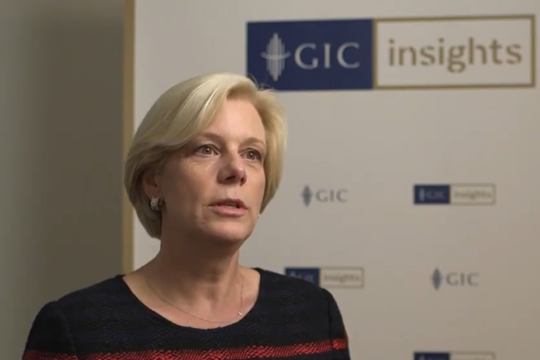
For years, the corporate world was entrenched in the practice of providing quarterly earnings per share (EPS) guidance. The latest data shows it may finally be on its way out.

For years, the corporate world was entrenched in the practice of providing quarterly earnings per share (EPS) guidance. The latest data shows it may finally be on its way out.
Quarterly EPS guidance constitutes a critical channel through which short-termism impacts companies and capital markets. By harnessing management teams to self-imposed short-term targets, quarterly guidance ensures that both investors and companies will focus on this time horizon.
Recently, FCLTGlobal partnered with NIRI to survey investor relations professionals on current quarterly guidance practices. According to those findings, the number of U.S. companies still issuing quarterly guidance has dropped significantly. Close to 50 percent of large-cap companies in 2004 put out quarterly forecasts, compared to 21 percent in 2023. Compare this to just 19 percent today of survey respondents that said they still continue the practice.
Figure 1: Percentage of S&P 500 Companies Offering Quarterly EPS Guidance
But why was quarterly guidance so widely adopted in the first place? Over the years, there have been several misconceptions.
The most pervasive myth behind quarterly guidance is that it’s good for your stock performance. This has been largely debunked – if anything, most companies issuing quarterly guidance underperform. With the rare exception, almost none of the largest companies use it since they recognize it as inherently short-term-oriented, including Apple, Microsoft, Nvidia, Amazon, Alphabet, Saudi Aramco, Meta, Berkshire Hathaway, TSMC, and Eli Lilly.
Furthermore, the average non-guiding company generated an annualized increase of 19.8 percent in market value from 2010 to 2023, compared to just 7.7 percent for guiders.
Table 1: Market value of non-guiding companies far exceed guiders between 2010 and 2023
| Type of Company | Increase in Market Value (CAGR) | Total Increase in Market Value ($ million) | Average Increase in Market Value ($ million) |
|---|---|---|---|
| Guiders | 7.7% | 2,905,993 | 42,116 |
| Non-Guiders | 19.8% | 17,448,523 | 59,755 |
In addition, 52 percent of survey respondents said they issue quarterly guidance because they think it minimizes stock volatility. In fact, the opposite is true – companies that have expanded their guidance range from quarterly to annual have experienced lower volatility compared to quarterly guiders.
Another misconception about quarterly guidance is that it is legally required. This has never been the case, but those assumptions have overridden the facts over the years. But today, only nine percent of respondents say they still provide quarterly guidance because they believe it is mandated.
Plus, most investors don’t want it either. Long-term investors don’t want short-term guidance, yet the assumption that it’s a requirement still prompts some companies to use it, which in turn pressures them into making counterproductive, short-term decisions. The overwhelming majority of questions from quarterly earnings calls come from sell-side analysts and other non-shareholders: most large institutional investors are working with holding periods of at least two to four years – not quarters.
As seen above, this couldn’t be further from the truth. And even if it were, leaders should make decisions based on what’s appropriate for their company, not the company next-door. Luckily, this mindset is increasingly getting left behind as a relic of the past. Our latest survey shows only nine percent are still using it because their competitors do.
Aside from its recent decline in the U.S., quarterly guidance was already an afterthought in many European markets (less than one percent of the Eurostoxx).
Nevertheless, for those respondents that issue quarterly guidance, 80 percent stated their main reasoning doing so was to “clarify expectations and earnings.” This begs the question: clarify for whom? Your large institutional investors care about the kind of long-term value creation you can’t capture looking at a quarter. What kind of investors do you really want to attract to support your business? Short-term guidance begets short-term pressures from short-term investors.
Instead, providing investors with a long-term roadmap focused on the fundamental economic drivers of the business and strategic goals can pivot focus from 3-month performance to the real objective: creating long-term value. If this poll is any indication, corporate sentiment is following suit: close to 90 percent of respondents say they would not delay a long-term, NPV-positive project just to meet short-term quarterly guidance, nearly double research from 2016.
In summary, the data from this recent poll and elsewhere demonstrates that quarterly guidance is no longer in vogue. Whereas in 2017, 24 percent of the market-value weighted S&P 500 did it, only 16 percent did the same in 2023.
Figure 2: S&P 500 Quarterly/Non-Quarterly EPS Providers by Market Value
So, for companies still issuing quarterly guidance, even though it’s not required, nobody truly wants it, and it’s bad for your stock price, it’s time to start considering alternative ways to communicate with your investors. 81 percent of your peers already have.

Investor-Corporate Engagement, Earnings Guidance | Report
23 October 2017 - Since 2005, research has consistently found that the vast majority of corporate executives think that short-term pressure is growing, that it is changing their business decisions, and that those changes are destroying value. One effective way that corporations are combating this phenomenon is by moving away from quarterly earnings per share (EPS) guidance and instead providing investors with a long-term road map focused on the fundamental economic drivers of the business tied to management’s outlook on critical key performance indicators (KPIs). As we highlighted in our...

Investor-Corporate Engagement | In the News
14 April 2020 - With a growing list of companies suspending earnings guidance, FCLT Global CEO Sarah Keohane Williamson explains why quarterly guidance can be problematic.

Earnings Guidance | Video
25 September 2017 - CEO Sarah Williamson shares her thoughts on quarterly guidance and companies' and investors' on going focus on quarterly results.